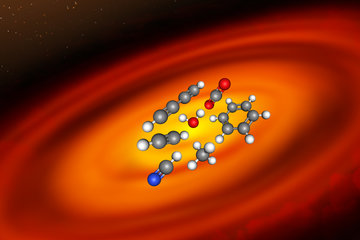Behind the scenes of protostellar disk formation

This image shows the protoplanetary disc surrounding the young star HL Tauri, revealing substructures within the disc that have never been seen before. It even shows the possible positions of planets forming in the dark patches within the system.
Although rotationally supported disks are frequently observed around young stellar objects, theoretical studies have found it difficult to form such disks. The main problem is the magnetic field in the interstellar matter, which will lead to the so-called “magnetic braking catastrophe”, even for moderate magnetic field strengths. In models using ideal magneto-hydrodynamics (MHD) the gas is “frozen” into the magnetic field, and the field lines are dragged towards the centre by the collapsing gas resulting an hourglass-shaped magnetic field. Strongly pinched field lines connect materials in the stellar vicinity and that in the envelope much further out, transferring angular momentum away from the centre. Even in non-ideal MHD models where neutral matter is allowed to drift relative to the magnetic field, the formation of rotationally supported disks remains difficult, if a standard ionization chemistry is used in computing the non-ideal MHD effects.

This image shows a colour composite of visible and near-infrared observations of the dark cloud Barnard 68. At these wavelengths, the small cloud is completely opaque because of the obscuring effect of dust particles in its interior.
“The problem are the tiny dust grains; if they are absent we do get a rotationally supported disk”, states Bo Zhao, lead author of the paper now published in MNRAS. “These tiny grains, easily charged by absorbing ions and electrons, are effective both in coupling to the magnetic field and in collision with their surrounding molecules. In other words, the neutral matter is still relatively well coupled to the magnetic field because of these tiny grains. However, if we remove them, the larger grains do not couple as effectively and the neutral matter of the cloud can sneak much faster through the magnetic field lines and eventually form a disk with enough rotation support.”

The collapse of a rotating molecular cloud leads to the formation of a large rotationally supported disk if very small grains are removed (b). The strong magnetic braking in the presence of very small grains suppresses the formation of such a disk (a).
Interstellar molecular clouds are made up of both gas and dust grains, with a “standard” distribution of grain sizes that includes a large population of nanometre-size grains. However, such a size distribution may not represent the denser part of the molecular clouds. In cold dense molecular clouds, tiny grains of nanometre size may behave as large molecules and freeze on the surface of larger dust grains. Further support for this idea also comes from centimetre-wavelength observations trying to detect emission from spinning dust grains; they too show a lack of tiny grains with size below a few nanometres in dense molecular clouds.

The plot on the left shows the density distribution in a collapsing gas cloud for the standard distribution of grain sizes. Even though there is a concentration towards the centre, the disk is not rotationally supported, i.e. not stable enough to form stars and planets. The plot on the right shows the same, but with the smallest grains removed. In this case, there angular momentum influx to the disk leading to a much larger, rotationally supported disk.
“When grains are mostly larger than 0.1 micrometres, the rotationally supported disks can become massive enough to be self-gravitating and evolve into rings”, says Zhao. “Such a structure in 3D could easily fragment into multiple stellar systems, which may also help explain the high multiplicity of stars in our Milky Way.”
“It is surprising to find that the removal of small dust grains can avoid the ‘magnetic braking catastrophe’ in disk formation,” says Paola Caselli, co-author of the paper. “This is a breakthrough in our understanding of how protoplanetary disks form. At the same time, it demonstrates that chemistry and microphysics are crucial to the fundamental processes in the field of star and planet formation."















